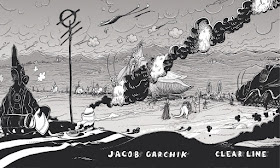Jacob Garchik
Clear Line
(Yestereve) jacobgarchik.bandcamp.com/
One of the defining moments of Clear Line occurs in the climax of "Moebius and Mucha." After trumpeters Jonathan Finlayson and Adam O'Farrill joust with each other, they inspire the 13 horns in the trombonist's latest project (Garchik only conducts and composes here) to create a descending line where 11 or 12 notes (it's hard to tell how many after awhile) are stacked on top of one another for a beautiful cluster of sound. When the ensemble comes together a moment later to quickly state a full chord, a sound echoes behind them that leaves a phantom note ringing in the ether. Whether they created a ghostly harmonic or one of the horns snuck that tone in behind everything, it's a testament to the power of acoustic instruments, still able to blow down walls or minds.
While Clear Line indeed features a baker's dozen of horns, Garchik jettisoned a rhythm section, not really needing one with four trumpets, three trombones, one bass trombone, two alto saxophones, two tenor saxophones and one baritone saxophone. They create some vast arpeggios in the opening piece, "Visualization of Interior Space" which might sound a little repetitive and Philip Glass-like (an approach Garchik utilized briefly in his Ye Olde album) were it not for the lifelike swirl of the horns as they rapidly fire off the notes. "Stacked Volumes" combines high-end dissonance, and long drones with silence, getting the saxophones to, among other things, create guitar feedback. In addition to the strong moments of group interaction, the music features pointed solos from saxophonists Anna Webber and Roman Filiu, and trombonists Natalie Kressman and Kalia Vandever and trumpeter Davy Lazar.
Garchik's inspiration came from a few sources, one remote and the other close to home. The music is his meditation on the "Ligne Claire" style of illustration first demonstrated by Hergé, who created the TinTin cartoon. ("Ligne Claire" is a song title, in fact.) Hergé drew his cartoon characters against a realistic background with solid lines and colors. Garchik's interest in architecture, graphic novels and scenery all factored into the music.
As a trombonist, Garchik has a long history of playing in big bands, a place where many musicians playing his instrument often spend a good deal of time. This group offered him a chance to break from the limitations of the style (screeching trumpets, woodwind doubling, mutes and "jazzy" harmonies among them) without mocking it or tearing it down. Sometimes things get a little rigid or repetitive but often times the repetition slyly evolves into another rich permutation of sound, again exploiting the possibilities of having this many horns at one's disposal.







